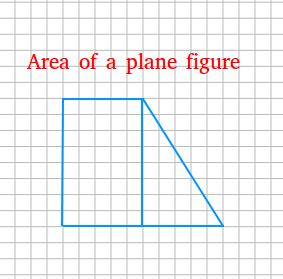Area of a plane figure
The area of a plane figure is the space enclosed by the plane figure. In other words, the area is the amount of space the plane figure takes in a two-dimensional plane.
You can think of the area of a plane figure as the number of square units it encloses.
For some plane figures such as rectangles, squares, triangles, and trapezoids, it may be easier to count the number of square units they enclose. However, for circles and ellipses, things get more complicated and special techniques are required to get accurate answers.
How to find the area of a plane figure

The figure above has the following 3 plane figures:
- Rectangle
- Triangle
- Trapezoid
Trapezoid = rectangle + triangle
Area of the rectangle
Suppose each square is equal to 1 square unit. To find the area of the rectangle, count the number of square units inside the rectangle.
Since the rectangle has 40 square units, the area is 40 square units.
You can get 40 faster if you multiply the width of the rectangle by the length.
Area of rectangle = width × length = 5 × 8 = 40
Area of the triangle
It is not easy to count the number of square units inside the triangle. However, the space enclosed by the triangle is half the space enclosed by the rectangle.
Area of the triangle = (width × length) / 2 = (5 × 8) / 2 = 20
For a triangle, it is best to say that 5 is the base and 8 is the height.
Area of the triangle = (base × height) / 2
Area of the trapezoid
Looking at our figure above, we see that the area of the trapezoid is equal to the area of the rectangle plus the area of the triangle.
Area of the trapezoid = 40 + 20 = 60
There is another way to get 60 although it is not easy to notice.
Just take the average of the parallel sides of the trapezoid and multiply the answer by the height of the trapezoid, which is the same as the height of the rectangle or triangle in this case.
One of the parallel sides (top one) is equal to 5 and the other (bottom one) is equal to 10.
[(5 + 10)/2] × 8 = (15/2) × 8 = 7.5 × 8 = 60
Let a be the length of one of the parallel sides of a trapezoid, let b be the length of the other side that is parallel to side a, and let h be the length of the height of the trapezoid.
Area of trapezoid = [(a + b)/2] × h
Area of a circle
The area of a circle is area = πr2 and it is not as easy to show by counting square units. Here is a proof of the area of a circle.